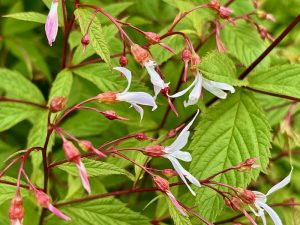Gillenia trifoliata – The Ethereal Grace of Bowman’s Root
Gillenia trifoliata, known by a host of common names including Bowman’s Root, Indian Physic, False Ipecac, Indian Hippo, and Western Dropwort, is a graceful perennial native to the eastern regions of North America. Belonging to the Rosaceae family, this clump-forming plant is prized for its airy presence in woodland gardens and its charming, star-shaped flowers. With delicate white or pale pink blooms and attractive seasonal foliage, Gillenia trifoliata is both an ornamental gem and a historical herb.
Botanical Heritage and Cultural Significance
This species is native to deciduous forests stretching from southern Ontario to Georgia and as far west as Louisiana. It thrives on upland slopes, rocky banks, and woodland edges. The name Bowman’s Root honors Dr. John Bowman, an early Virginian botanist, while Indian Physic reflects Indigenous medicinal use. Tribes such as the Cherokee and Iroquois used the plant’s powdered root as an emetic and for treating digestive ailments, colds, and other minor illnesses.
Distinctive Floral Display
The flowers of Gillenia trifoliata appear in open sprays from late spring to early summer, with individual blooms about 3 to 4 cm (1.2–1.6 in.) wide. Each starry flower consists of five slender, slightly twisted petals that are unequal in length. They emerge atop wiry, branching red stems, creating a light, cloud-like effect above the plant. Even after the flowers fall, the persistent red calyces continue to provide ornamental interest through the seasons.
Deciduous Foliage and Habit
The plant forms an upright, bushy mound, reaching about 1 meter (3.3 feet) tall and wide. It has three-lobed foliage, slightly toothed leaflets with a bronze-green hue that warms to orange-red in autumn. These compound leaves, along with red stems and elegant flowers, give the plant a highly refined yet natural look, perfect for softening edges in mixed borders or woodland settings.
Growing Conditions and Garden Use
Gillenia trifoliata excels in partial shade and appreciates dappled sunlight, mimicking its woodland habitat. It can handle full sun in cooler or consistently moist areas but prefers protection from harsh afternoon rays. The plant favors well-drained, slightly acidic soil enriched with compost or leaf mold. It tolerates loam, clay, or rocky substrates as long as drainage is adequate.
This low-maintenance perennial is ideal for woodland gardens, native plantings, naturalized borders, and pollinator-friendly beds. Its upright form, delicate flowers, and autumn color make it a season-spanning addition to diverse designs.
Care and Maintenance of Gillenia trifoliata
Light: Gillenia trifoliata prefers partial shade to dappled sunlight, mimicking the light conditions of its native woodland habitat. While it can tolerate full sun in cooler regions with consistent moisture, intense afternoon sun in hotter climates may cause leaf scorch. For best results, plant it in a location with morning sun and afternoon shade or under light canopy cover.
Watering: Regular watering is essential during the first year. Once established, Gillenia trifoliata prefers evenly moist soil but is tolerant of occasional dry spells. Water at the base to reduce the risk of foliar diseases.
Fertilizing: This plant is not heavy-feeding. A single application of balanced, slow-release fertilizer in early spring is usually sufficient. Alternatively, enriching the soil with compost annually will keep the plant thriving.
Pruning: Minimal pruning is needed. Remove dead or damaged stems in late winter or early spring. Some gardeners choose to cut back the plant in autumn for tidiness, but its winter structure is subtle and attractive.
Propagation: Propagate by division in early spring or autumn. Seeds may also be used but require stratification for successful germination. Divisions should include multiple roots and buds to ensure healthy re-establishment.
Pests and Diseases: Gillenia trifoliata is remarkably pest and disease-resistant. Ensuring good air flow and drainage will help prevent fungal issues in damp climates.
Winter Care: The plant is hardy and requires little winter protection. In colder climates, mulching the base helps protect the root crown. The old stems can be left over winter to support overwintering insects and provide structure.
Flowering Season and Longevity
This perennial typically blooms from April through June, offering a three-week display of delicate white flowers. Though it flowers just once per season, its long-lasting visual impact continues with red seed calyces and colorful fall foliage. Plants can live and thrive for many years with minimal intervention.
Final Thoughts on Gillenia trifoliata
Gillenia trifoliata stands out for its understated charm, seasonal elegance, and resilience. Whether planted as a textural foil in a shaded border, a focal point in a native garden, or a nectar source in a pollinator patch, this North American wildflower brings grace and quiet drama. Its long cultural history, ecological value, and adaptability make it a plant worth celebrating and growing.



